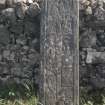Following the launch of trove.scot in February 2025 we are now planning the retiral of some of our webservices. Canmore will be switched off on 24th June 2025. Information about the closure can be found on the HES website: Retiral of HES web services | Historic Environment Scotland
Skye, Glasvin, Glen Dale, St Comgan's Chapel
Burial Ground (Medieval), Chapel (Medieval)(Possible), Font (Medieval), Grave Slab (Medieval)
Site Name Skye, Glasvin, Glen Dale, St Comgan's Chapel
Classification Burial Ground (Medieval), Chapel (Medieval)(Possible), Font (Medieval), Grave Slab (Medieval)
Alternative Name(s) St Congan's Chapel; St Comgan's Chapel; Kilchoan Burial Ground; Cille Chomhghain In Glendale; Glendale, Carved Slab; Gleann Dail
Canmore ID 10556
Site Number NG14NE 1
NGR NG 1771 4976
Datum OSGB36 - NGR
Permalink http://canmore.org.uk/site/10556
- Council Highland
- Parish Duirinish
- Former Region Highland
- Former District Skye And Lochalsh
- Former County Inverness-shire
Glendale A concentration of crofting townships sprawling along the fertile Hamara strath, and up its lower slopes. See p.258 for the story of the Glendale Martyrs. On the river's north bank, a walled burial ground of medieval origin, notable for one gravestone, 14 th/15th century, depicting a rare harpist figure, with religious and secular symbols - a bishop, chalice, claymore and foliage - carved beneath.
Taken from "Western Seaboard: An Illustrated Architectural Guide", by Mary Miers, 2008. Published by the Rutland Press http://www.rias.org.uk
NG14NE 1 1771 4976
(NG 1771 4976) Congan's Chapel (NR) (Site of)
OS 6" map, Inverness-shire, 2nd ed., 1904.
Cille Chomhghain in Glendale, (W J Watson 1926) S. Congan's (or more correctly St. Congan's) (A P Forbes 1872) Chapel, the site of which is said to have been in Kilchoan burying-ground, but no trace of it now remains. In the burial ground is an old bourtree and a sculptured slab (not dated but fully described and illustrated) (RCAHMS 1928) set upside down as a headstone to a modern grave. A font, described as a rough-hewn hollowed out stone was not seen.
Visited by OS (C F W) 6 December 1960.
A P Forbes 1872; F T Macleod 1910; A B Scott 1918; W J Watson 1926; RCAHMS 1928; W D Simpson 1935.
Although there is nothing to be seen of this chapel, foundations have been encountered when digging graves 16m ENE of the published site (Information from Mr Mackinnon, Glendale Post Office). The scupltured slab noted by the RCAHMS (a medieval - c.15th century - grave-slab) no longer serves as a headstone, but leans against the wall of the burial ground, just inside the S entrance; the font is built into the top of the wall near the E side of the entrance. The burial ground is still in use and has been extended.
Visited by OS (C F W) 12 May 1961.
Late medieval carved grave-slab in graveyard of 'Congan's Chapel' - scheduled.
Information from OS (I F), 18 April 1974.
Scheduled as St Comgan's Chapel, tombstone Glendale (within Kilchoan graveyard, Glasvin, Glendale).
Information from Historic Scotland, scheduling document dated 21 December 2000.
Field Visit (7 May 1915)
Carved Slab, Congan's Chapel, Glasvin, Glen Dale.
In Kilchoan burying ground at Glasvin, Glen Dale, which is said to contain the site of St Congan's church, is a sculptured slab set upside down as a headstone to a modern grave. It measures 4 feet 8 inches in height above ground and about 16 inches are buried; it is 17 ½ inches in breadth and about 3 inches in thickness, the top, which was the original lower end, terminating in an obtuse angle. It has been bordered by a slight moulding, 1 inch broad about 1 ½ inches from the edge of the stone. The upper part of the panel contained within this moulding, which is at present obscured, bears a man seated playing the harp; the lower part is occupied by a claymore or hand-and-half sword with depressed quillons and a fan-shaped pommel terminating in a spike. The stone is much weathered, but on the dexter side of the blade and hilt a running foliaceous design can be traced, while the sinister side of the weapon is divided into four panels, one opposite the hilt and three opposite the blade, three of which bear designs. The higher panel, above the quillon, contains the front view of a mitred ecclesiastic, apparently holding a crozier in his right hand; a long stemmed chalice occupies the panel immediately below the quillon, and the lower panel is filled with what seems to be a foliaceous scroll, while the central compartment is devoid of ornamentor perhaps weathered away. (Fig. 244.)
Every trace of the ancient church has disappeared, but near the centre of the burying ground an old bourtree bush of large dimensions is said to have sprung from seeds contained in the pockets of the son of a Norwegian chief who was buried here. Some years ago a crofter cut some twigs from the tree and carried them to his house. His slumbers were disturbed that night by the appearance of the spirit of the Viking, which protested so strongly against this act of desecration that the crofter carried the branches back next day. The font described in the Proceedings (Vol. XLIV., p. 382) was not seen.
RCAHMS 1928, visited 7 May 1915.
OS map: Skye xx.





















